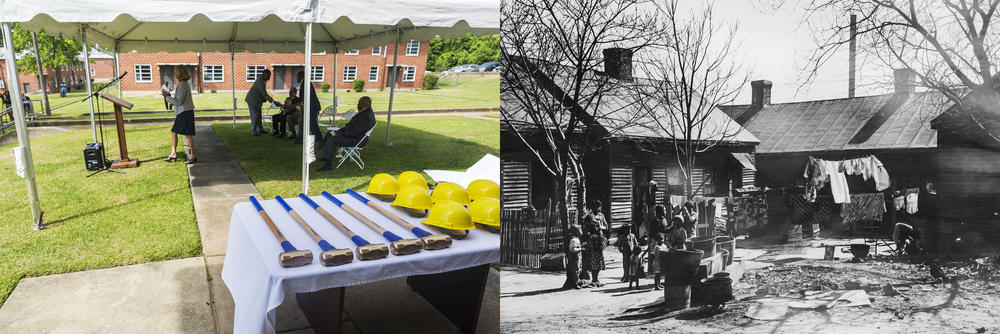Section Branding
Header Content
How Far Can You Get From Public Housing (With Help?)
Primary Content
How Far Can You Get From Public Housing (With Help)?
The asbestos was already being removed from Tindall Heights by the time the politicians were ready to celebrate its demolition.
Thelma Dillard was one of the local politicians there to say goodbye before the pre-demolition press conference. She serves on the local school board and grew up in the over 70-year-old public housing project.
“My mother moved here when I was a baby. And I lived here until I went off to college,” Dillard said.
Dillard said once upon a time this was the place to be.
“A lot of good people grew up in this neighborhood,” she said. “It was a launch pad for greatness.”
These 400 or so blocky apartments built during the New Deal were radically better than the tarpaper shacks they replaced. By 1960 the wiring was out of date and there has never been central air conditioning here, this in the middle of Georgia. So Thelma Dillard was all too happy to pick up a sledgehammer, painted gold of course, and take a turn knocking out a few ceremonial bricks.
What will come next will be low-cost housing for senior citizens on about a third of the property and, should some tax credits come through, a larger mixed income retail and residential development on the rest.
But first everyone here has to go. That presents both a promise and a challenge, both of which came to different ends for two women here in Tindall Heights.
First, the promise.
One day last October when this was still news in the neighborhood, people talked about what they would like to happen once they moved. Some like George Neel were indifferent.
“It doesn't really matter. Whatever I can afford basically,” he said.
Some like Diane Collins didn’t want to go.
“I really got attached to my apartment,” she said.
But most of the people I spoke with were single mothers like Auset Reaves with one thing on their mind.
“I just think it’s time for me and my kids to move onto something better,” she said on the stoop of her apartment in the heart of Tindall Heights. “Well, the school's he's at, it's OK. But I want more for him.”
Reaves, 25, is a mother of four and in school herself.
“I was already ready to move. And I'm excited about it. And I'm glad that they doing this,” she said.
Luckily for Reaves, she, and everyone else here, would have some monetary help. That would come in the form of a Section 8 tenant protection voucher, or TPV for short. Section 8 is the rent subsidy program that helps ease low income renters into the open housing market. The TPV is the help under Section 8 you get when you’re public housing is torn down.
So what’s out there for someone with a Section 8 Tenant Protection Voucher?
Last October at the start of the housing search, the Housing and Urban Development website listed something like eight Section 8 compliant apartments in Macon-Bibb. Turns out that despite HUD being the place landlords sign up to take Section 8, they don’t keep any sort of master list of those landlords. The Macon Housing Authority keeps a local Section 8 landlord list, but it’s available by appointment only. Residents in Tindall Heights would only see it when they engaged with one of the housing counselors working to place them in a new home. Other websites like gosection8.com and georgiahousingsearch.org yielded more results.
So with moms in mind, a map was made of just under 200 properties against a backdrop of elementary school performance, specifically third grade literacy as described by the 2015 Georgia Milestones test. Most places were apartments clustered in the lowest performing elementary schools zones in the city. There wasn’t a single property in the highest performing school zone.
Connie Smith heads up the team of housing counselors at the Macon Housing Authority. She said that the majority of new rentals have been in zip codes 31204 and 31206, both of which are served mostly by schools where between 4 and 8 per cent of third graders are reading at or above grade level. Some of 31204 is served by Taylor Elementary School where almost 20 per cent of third graders are reading at or above grade level. The highest performing school had 38 per cent of third graders at or above grade level in reading.
Six months after Auset first got news of the demolition and her move, Tindall Heights looked and sounded like a ghost town. Folks were clearing out. But, Auset Reaves was still there, waiting to move to her new place.
“It's a three bedroom house and it's two bathrooms and I love it,” she said.
She had been waiting for weeks to find out if the place met the health and safety standards for using Section 8 vouchers. Just getting to that point wasn’t easy.
“It hasn't been like a walk in the park like. ‘Oh, can go find this then you get to move,’” Reaves said.
First, she only had 60 days to look around. That didn’t feel like a lot of time.
“You might not find something in 60 days. It was like I have to find something like as soon as possible or I’m going to get messed up,” she said.
And though Reaves is happy with what she found, it isn’t her first choice. That was a house on Vineville Avenue, one of the more well-to-do arteries running from downtown Macon out to the Northern suburbs. Along the way, her excitement and the sense of promise that came with it cooled.
“No, you can't get your hopes up too high,” she said. “I know that we all happy about being able to move, but it's still like you have all these disadvantages.”
For Reaves, the main disadvantage was the value of the Section 8 TPV voucher itself. It turned out it just wouldn’t cover enough of the rent for her first choice house.
What she could afford was to move her nine-year-old son to a home off of Napier Avenue in Macon, to an elementary school with one of the lowest rates of literacy in the city. The school next to Tindall Heights was better and even it was struggling.
It didn’t matter. Reaves was set on go, but she was clearly tired and not a little disappointed.
“I'm ready for a change. I’m really ready for a change. This what it's mostly about. Ready for a change,” she said, her voice trailing off.
Of course if more landlords took Section 8 vouchers in better neighborhoods this would be easier. June Parker, head of the of the Macon Housing Authority, said they try to make that happen. But she said, if landlords can’t be convinced, their hands are tied.
So Auset gets to move, and she gets a house, just maybe not the home of her dreams. But there are two stories from two women here. Let’s go all the way back to the demolition party where Thelma Dillard took a whack with the sledgehammer to meet Tyra Ann Tate, where she waited for her turn to take swing.
She just left her apartment at the top of Tindall Heights for a rowhouse in the North Macon suburbs. Tate moved to Tindall Heights three years ago just after her divorce. She had three daughters with her and she was homeless.
“I didn't go in there with a mindset that I would be there long,” she said.
Her new place is a rowhouse on a street tucked between neighborhoods of single family homes. Some you could call McMansions. The single best elementary school in town is half a mile away, accessible by sidewalks. On a recent morning, there was incense burning and reggae streaming on the TV. It was chill, relaxing. Especially on the screened in back porch.
“I get to wake up and look at the lake every morning,” she said.
Sure enough, there was a small lake just over her fence. Birdsongs filled the air.
Tate has done nails for twenty years. She’s been working hard to build clientele in Macon in the time since she came here from Cleveland, Ohio. She’d been trying leave Tindall Heights for a while when she got the news about the demolition and the Section 8 vouchers. She got to work.
“Me and my middle girl, my 22-year-old, we would just ride around neighborhoods you know get numbers, look on Craigslist, the newspaper, everywhere,” she said. “Everybody just kept on showing us these garbage places. They were just terrible. I would actually want to ask them ‘Would you put your mother in this place?’”
But Tate said she had an image in her head of what was good enough. She kept on looking.
Then one day she was making small talk while doing nails for an old client. She talked a little about the house search. The client and her boyfriend were fixing a place up, told Tyra to take a look. She did, the same day.
“And when I walked in I was like wow this this is I'm done. The search is over,” she said.
Except the landlord wasn’t taking section 8. Again, Tate was persistent. She laid it on the line with the landlord.
“I just was basically was like me and my girls deserve...we need a place, a nice safe environment for us to live,” she recounted. “You know we're all in school ,we're good people, we won't tear up your house and I know that's you know a stigma that people have with Section 8.”
The landlord bit. He signed up to accept Section 8 and rented Tate the house. As far as Tate is concerned, this is how the whole thing was supposed to work.
“This is one of the reasons for Section 8. So you can upgrade your life,” she said. “You don’t want to go from a project to a slum.”
Tyra Ann Tate says that just wouldn’t make sense.
Support for Health, Education, and Poverty reporting on GPB Macon comes from the Peyton Anderson Foundation.


